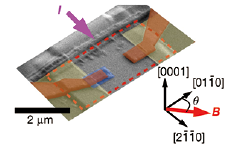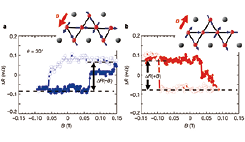Magnetic Spin Hall Effect in a Non-Collinear Antiferromagnet
Otani and Nakatsuji Groups
The conventional spin Halle effect (SHE) converts electrical currents to transverse spin currents in non-magnetic conductors in response to an electric field. The SHE has thus drawn much attention as a means to switch the magnetization of the adjacent ferromagnetic layer via spin orbit torque. New functions have been further explored in various materials in terms of spin-charge currents interconversion. The magnetic contribution to the SHE has therefore been studied intensively in these days. Here we show that antiferromagnets have richer spin Hall properties than that of non-magnetic materials. The material focused on here is Mn3Sn, which shows non-collinear antiferromagnetic order of Mn magnetic moments that have an inverse triangular spin configuration on stacked kagome lattices [1]. We find non-trivial time reversal-symmetry-breaking counterparts of the conventional SHE, which is called magnetic spin Hall effect [2].

Fig. 1. Scanning electron microscope image of the spin-accumulation device. The microfabricated Mn3Sn single crystal is indicated by the red dashed line. A NiFe ferromagnetic electrode and non-magnetic Cu electrodes are indicated by blue and brown areas, respectively. The edge of the Mn3Sn crystal indicated by yellow area is covered with a 30-nm-thick Al2O3 insulating layer to avoid electrical contact at the edge.

Fig. 2. Spin-accumulation signal. a, b, Magnetic-field dependence of resistance measured between the NiFe and Cu electrodes at room temperature. The results in aand bwere obtained after saturation of Mn3Sn with a sufficiently large magnetic field Bof −0.75 T and +0.75 T, respectively. The corresponding spin structures of Mn3Sn are shown in the insets.
To study the SHE in a non-collinear antiferromagnet, we fabricated a device consisting of ferromagnetic NiFe and non-magnetic Cu electrodes formed on the top surface of a microfabricated 100-nm-thick Mn3Sn single crystal (see Fig. 1). An electric current was applied along the [2110] axis and the voltage was measured between electrodes aligned along the [0110] axis, perpendicular to the current. If current inside Mn3Sn generated spin accumulation with a component parallel to the NiFe magnetization, it would shift the electrochemical potential across the Mn3Sn/NiFe interface and can therefore be detected as a voltage between NiFe and the Cu electrodes. A rectangular resistance–magnetic field (R–B) hysteresis loop corresponding to the switching of NiFe magnetization is expected for a fixed polarization direction of the accumulated spins. Such a rectangular R–B hysteresis loop was observed in the magnetic-field dependence of the transverse voltage between NiFe and the Cu electrodes. The results in a and b were obtained after saturation of Mn3Sn with a sufficiently large magnetic field B of −0.75 T and +0.75 T, respectively, which provide evidence that the rectangular loops originate from spin accumulation at the Mn3Sn surface. The key observation in this work is that the spin accumulation signal changes indicate when the Mn3Sn sub lattice moments are reversed, as illustrated in the inset. This unexpected sign change demonstrates that the dominant contribution to the SHE in Mn3Sn is odd under time reversal. We find that in the non-collinear antiferromagnet Mn3Sn, the SHE has an anomalous sign change when its triangularly ordered moments switch orientation. This discovery expands the horizons of antiferromagnet spintronics and spin–charge coupling mechanisms.
References
- [1] S. Nakatsuji et.al., Nature 527, 212 (2015)
- [2] M. Kimata et.al., Nature 565, 627 (2019)
